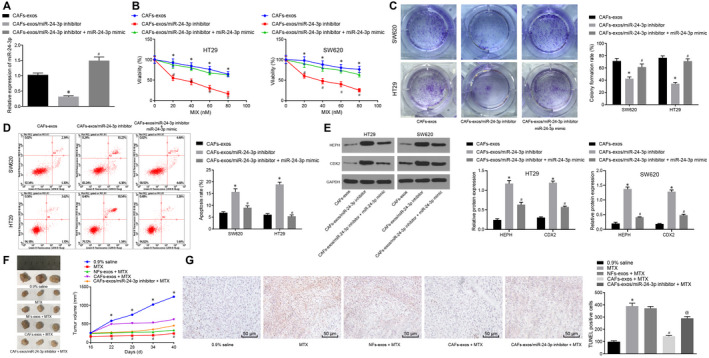Figure 7.

CAFs‐derived exosomal miR‐24‐3p promotes CC cell resistance to MTX. HT29 and SW620 cells were treated with CAFs‐exo, CAFs‐exo/miR‐24‐3p inhibitor or CAFs‐exo/miR‐24‐3p inhibitor + miR‐24‐3p mimic. A, The expression of miR‐24‐3p in exosomes measured by RT‐qPCR normalized to U6. B, Cell viability determined by CCK‐8 assay after cultured CC cells treated with MTX for 5 d. C, Colony formation analysis. D, Apoptosis analysed by flow cytometry. E, The protein expression of CDX2 and HEPH determined by Western blot analysis normalized to GAPDH. Mice were treated with 0.9% saline, MTX, NFs‐exo + MTX, CAFs‐exo + MTX or CAFs‐exo/miR‐24‐3p inhibitor + MTX (n = 10). F, The volume of the tumours. G, Apoptosis of the tumour tissue measured by TUNEL staining (n = 10; ×200). * P < .05 vs HT29 and SW620 cells treated with CAFs‐exo or mice injected with 0.9% saline. # P < .05 vs HT29 and SW620 cells treated with CAFs‐exo/miR‐24‐3p inhibitor or mice treated with MTX. @ P < .05 vs. mice injected with CAFs‐exos + MTX. Measurement data were expressed as mean ± standard deviation. Comparisons among multiple groups were conducted by one‐way analysis of variance (ANOVA). Data at different time‐points were compared by repeated‐measures ANOVA, followed by Bonferroni's post hoc test. The cell experiment was repeated three times
